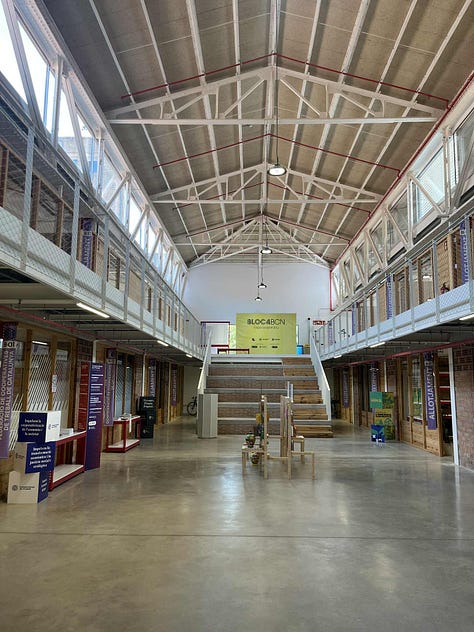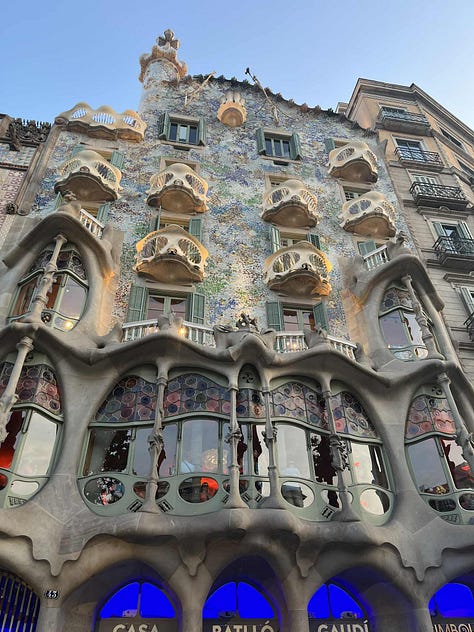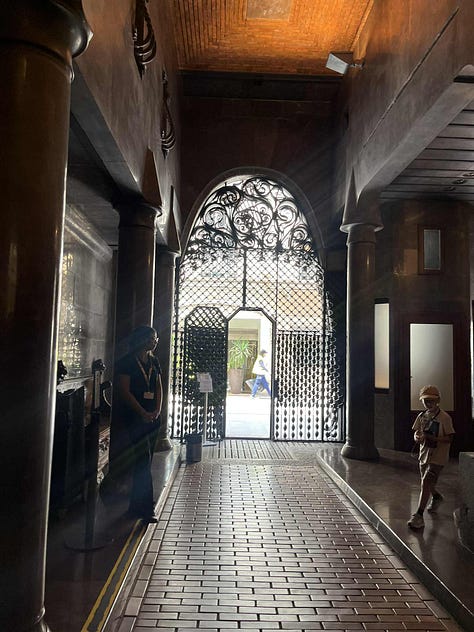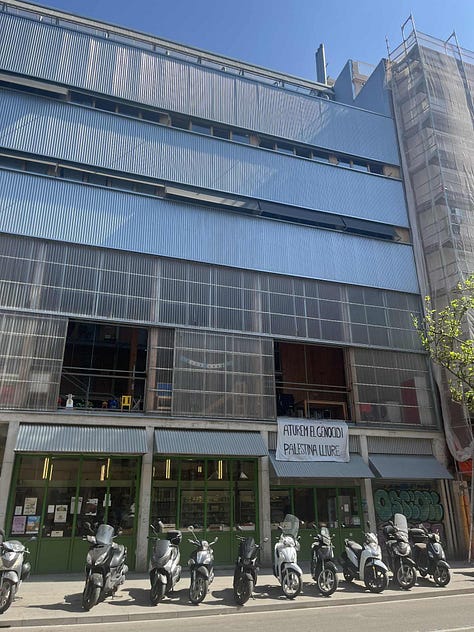It’s hot and humid in Barcelona.
The jacarandas are limp, desperate to hold onto their last drops of colour. The petals fall like purple dust and then disappear on the sizzling grey floor. There is no grass here. I’m sure that’s true of lots of places – lots of hot places, but I’m surprised by it. The playgrounds are built on dirt, or fake spongy stuff, or concrete.
As an Australian, a 29-degree day shouldn’t illicit this kind of sweat. I’m a disgrace. Finally appreciating the importance of siestas not as day naps but as a time when no human being should be out in this heat. It doesn’t help that I’m walking everywhere, all over the Barcelona sprawl. There is amazing tree canopy and yet such an overwhelming commitment to concrete. I’m aware that a better plan would be to take the easily accessible metro – but I don’t want to miss anything.
There’s so much to see. Massive roundabouts with roads coming out in all directions like tentacles. Equally massive centre piece statutes form their own tourist attractions. Gothic cathedrals with pointy tops. Small alleyways with Arabic script on the shop descriptions that take me to Morocco. Close to the port are densely packed apartment blocks with colourful laundry overhead creating a type of canopy and (blessedly) some shade. And then the modernism. The Gaudi. Buildings that seem to emerge from the earth like stalactites or float on the land from the sea. I love the curves and the light, the natural material and the number play. Gaudi’s ideas were ahead of his time and put Catalonia on the map.
I’m here in Barcelona because it’s a city that tries new things. In recent history, the GFC hit hard here. A town planner tells me that the Spanish economy is now on the mend. He proudly demonstrates this by telling me the war in Ukraine hasn’t affect Spain as much, as they’re now producing more of their own electricity. They want local solutions to their past economic woes.
In terms of affordable housing, Barcelona has become a place known for its limited equity cooperative housing. Of course, this model isn’t new – and we’ll revisit cooperative housing after my time in New York – but Barcelona is building a system. Let me go back a step – or perhaps pause for a second in the shade.
I hear a very similar story from the people I speak to in Barcelona. I ask them how they got into their current field, and they tell me about a moment where they had an identity crisis. The economist that hated making corporations wealthy. The finance specialist who didn’t agree on how the numbers added up. The architects that wanted to design communities, not just houses. I talk to a sociologist who is doing research on what he calls degrowth architecture. Everyone seems to have wanted more, or rather less, or maybe more value from less things.
The overarching salvation came in the way of a new movement or way of thinking that favoured local, communal activity and reciprocity over individual profit. And while there were a few different phrases to describe people’s beliefs, I think most can be seen as framing their debate as part of Social and Solidarity Economy.
An economist explains the word economy to me. ‘It's just a system to distribute resources in a world in which resources are finite,’ she tells me. She left the field but is now back. I tell her she’s reformed and she laughs and agrees. We talk about human rights – about how the lack of adequate housing can stop people from their right to work, their right to education. But her argument isn’t a legal one, but rather set within the economy. No single actor should win. Not all transactions need to be extractive. We talk about the Climate Crisis. We talk about fairness and efficiency. Housing that is locally owned and democratic leads to a stronger economy. For instance, if an overseas equity firm owns a block of housing, they may sell it to offset a loss in another market. That’s not fair, but it also makes your local market volatile to external, overseas markets. Finacilisation of the housing market weakens the economy.
The GFC seems to be a defining moment in Spain’s economic and housing history. Another colleague tells me that Spanish housing subsidies pre-GFC were focused on home ownership (sound familiar?) Many people lost their homes. Left with few resources, Barcelona focused on leavers within its power. Planning, mandatory inclusionary zone, long-term land leases of public land – and these subsides went to rental accommodation, so they didn’t bleed out and affordability would remain. The history of cooperatives is the government’s success story too. The cooperative hubs are often located on buildings/land from the city.
I visit three cooperative hubs while in Barcelona and walk to all of them. On my third day I surrender to wearing shorts to my professional meetings – like many of the people I talk to do. There’s a practicality to the way my colleagues in Barcelona work. The buildings we meet in are well designed, not at all ostentatious, and cool from the heat. One of the cooperative hubs I visit turns into a bar in the evening, when the office workers are gone. There’s a pride to the idea of spaces with multiple functions and multiply ways to fund the whole endeavour.






There are lots of subtleties between the various cooperative types. Here are two examples. Sostre Civic is a cooperative (interestingly, each employee is a member of the cooperative) that is an umbrella organisation with, as it was translated to me, sub cooperatives. Each sub group is a distinct development, but part of the larger entity. The structure is there both to ensure that housing remains affordable in perpetuity, but also so each new development has access to extensive cooperative experience. It’s efficient use of resources.
La Dinamo also helps individuals join together to create housing cooperatives. Their advice comes with a fee. They use other organisations within the larger cooperative hub, such as architects and legal advice, to help each individual development. La Dinamo is also a charity – indeed they are a foundation – and can accept donations and provide grants and loans. Some of those donations are land, which ultimately become a cooperative.
‘Do you all get along?’ I ask one of the cooperative members. He smiles and asks me if I’ve watched Monty Python. I immediately pitch my voice high and sing out ‘I thought we were an autonomous collective!’, before I realise he was referring to a different skit from another movie. I wiped the sweat from my brow. Although in my defence, the right to local self-determination seems to be at the heart of the cooperative movement here.
The magic to the Barcelona collaborative housing experience is finding something that works once and then doing it again, and then again. Slow and steady, one person to join others to build one cooperative at a time. My colleague tells me about how much progress they’ve made. ‘Ten years ago, it was like zero.’ She tries not to get exacerbated by the pace. ‘I have to remind myself…like chill.’ In many ways, this is one of the most valuable reminders I’ve had so far. It’s one unit, one development, one family, one at a time. I could say that Australia should join the movement, but it’s more about building something yourself, locally, rather than mere solidarity.
Some resources if you want to learn more:
· Sostre Civic and La Dinamo. Both produce resources in English.
· Cooperative Housing International have a quick overview of Financing.
· Funding the Cooperative City: Community Finance and the Economy of Civic Spaces is a very large publication on funding cooperatives. This one is dense but worth it.
· And here’s the skit from The Life of Brian about the People’s Front of Judea…or is it the Judean People's Front.





So long as you didn't say 'no-one expects the Spanish Inquisition'